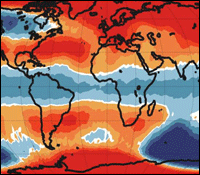| The earth's four jet streams mark the
boundaries of regional climates. In the Northern and Southern
Hemispheres, these rivers of high-speed wind persist at the border of
warm, tropical air and its cooler counterpart toward the poles. The jet
streams push weather across the globe, blessing some areas with abundant
rain and desertifying less fortunate regions. Now, new satellite data
reveals that the atmosphere is warming most strongly in such boundary
regions and potentially shifting regions of wet and dry.
U.S. satellite data since 1979 has revealed that the troposphere--the
weather-bearing layer of our atmosphere that extends more than seven
miles up--warmed the most, by roughly 1.5 degrees Fahrenheit, in the
middle latitudes. This band of warming crosses the southern U.S. as well
as southern China and North Africa in the Northern Hemisphere and
southern Australia, South Africa and lower South America in the Southern
Hemisphere. This warmer air expands the reach of the tropics and pushes
the jet streams toward the poles. "We estimate that the jet streams in
both hemispheres have shifted poleward by roughly 1 degree latitude in
both summer and winter seasons," the researchers, led by Qiang Fu of the
University of Washington, write in today's Science. Each degree
of latitude represents roughly 70 miles.
| "The jet streams mark the edge of
the tropics, so if they are moving poleward that means the
tropics are getting wider," explains John Wallace, Fuís
colleague at the University of Washington and coauthor of the
report. "If they move another two to three degrees poleward in
this century, very dry areas such as the Sahara Desert could
nudge farther toward the pole, perhaps by a few hundred miles."
It remains unclear what specifically is driving the move,
though climate change is a likely suspect, along with depletion
of the ozone layer. "Regardless of the cause," the authors note,
"the poleward shift of the jet streams and the associated
subtropical dry zone, if it continues, could have important
societal implications." --David Biello |
|
To subscribe or visit go to:
http://www.sciam.com/
The Scientific American |
